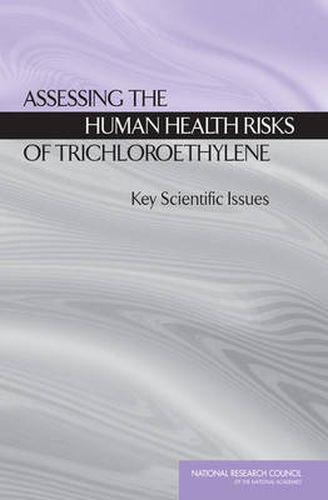Readings Newsletter
Become a Readings Member to make your shopping experience even easier.
Sign in or sign up for free!
You’re not far away from qualifying for FREE standard shipping within Australia
You’ve qualified for FREE standard shipping within Australia
The cart is loading…






Trichloroethylene is a chlorinated solvent widely used as a degreasing agent in industrial and manufacturing settings. It is also used as a chemical intermediate in making other chemicals and is a component of products such as typewriter correction fluid, paint removers, adhesives, and spot removers. In 2001, EPA issued a draft health risk assessment and proposed exposure standards for trichloroethylene. PA’s Scientific Advisory Board (SAB) reviewed the draft and it was issued for public comment. A number of scientific issues were raised during the course of these reviews.
Assessing the Human Health Risks of Trichloroethylene identifies and assesses the key scientific issues relevant to analyzing the human health risks of trichloroethylene, considering pertinent toxicologic, epidemiologic, population susceptibility, and other available information, including relevant published scientific literature, EPA’s 2001 draft health risk assessment of trichloroethylene, scientific and technical comments received by EPA from public and private sources, and additional relevant information to be provided by the sponsoring agencies. This report highlights issues critical to the development of an objective, realistic, and scientifically balanced trichloroethylene health risk assessment.
Guidance for hazard characterization of trichloroethylene is presented in Chapters 2 through 10. Chapter 2 provides guidance for evaluating large sets of epidemiologic data. In Chapter 3, the committee applies this guidance as an example in its evaluation of the epidemiologic data on trichloroethylene and kidney cancer, and this example should help guide evaluations of other cancer risks. Chapter 3 also assesses new information on the kidney toxicity of trichloroethylene and its metabolites and potential modes of action. Chapters 4, 5, 6, 7, and 8 evaluate the key issues regarding liver toxicity and cancer, reproductive and developmental toxicity, neurotoxicity, respiratory tract toxicity and cancer, and immunotoxicity, respectively. However, the committee’s review focused on mode-of-action information to understand how trichloroethylene might affect certain processes differently in different species. Chapter 9 discusses susceptibility to trichloroethylene and its metabolites, and Chapter 10 describes important factors in considering trichloroethylene in mixtures. Physiologically based pharmacokinetic models are evaluated in Chapter 11, and guidance is provided on future directions for model development. Finally, Chapter 12 considers issues related to dose-response assessment and quantitative assessment of risk.
$9.00 standard shipping within Australia
FREE standard shipping within Australia for orders over $100.00
Express & International shipping calculated at checkout
Trichloroethylene is a chlorinated solvent widely used as a degreasing agent in industrial and manufacturing settings. It is also used as a chemical intermediate in making other chemicals and is a component of products such as typewriter correction fluid, paint removers, adhesives, and spot removers. In 2001, EPA issued a draft health risk assessment and proposed exposure standards for trichloroethylene. PA’s Scientific Advisory Board (SAB) reviewed the draft and it was issued for public comment. A number of scientific issues were raised during the course of these reviews.
Assessing the Human Health Risks of Trichloroethylene identifies and assesses the key scientific issues relevant to analyzing the human health risks of trichloroethylene, considering pertinent toxicologic, epidemiologic, population susceptibility, and other available information, including relevant published scientific literature, EPA’s 2001 draft health risk assessment of trichloroethylene, scientific and technical comments received by EPA from public and private sources, and additional relevant information to be provided by the sponsoring agencies. This report highlights issues critical to the development of an objective, realistic, and scientifically balanced trichloroethylene health risk assessment.
Guidance for hazard characterization of trichloroethylene is presented in Chapters 2 through 10. Chapter 2 provides guidance for evaluating large sets of epidemiologic data. In Chapter 3, the committee applies this guidance as an example in its evaluation of the epidemiologic data on trichloroethylene and kidney cancer, and this example should help guide evaluations of other cancer risks. Chapter 3 also assesses new information on the kidney toxicity of trichloroethylene and its metabolites and potential modes of action. Chapters 4, 5, 6, 7, and 8 evaluate the key issues regarding liver toxicity and cancer, reproductive and developmental toxicity, neurotoxicity, respiratory tract toxicity and cancer, and immunotoxicity, respectively. However, the committee’s review focused on mode-of-action information to understand how trichloroethylene might affect certain processes differently in different species. Chapter 9 discusses susceptibility to trichloroethylene and its metabolites, and Chapter 10 describes important factors in considering trichloroethylene in mixtures. Physiologically based pharmacokinetic models are evaluated in Chapter 11, and guidance is provided on future directions for model development. Finally, Chapter 12 considers issues related to dose-response assessment and quantitative assessment of risk.